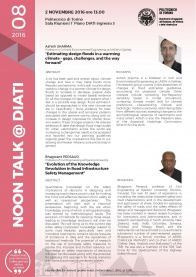08 - Nook Talk@DIATI - 2 seminari
Mercoledì 2 novembre 2016 - ore 13:00 - Sala Riunioni 1° Piano DIATI ingresso 3, Politecnico di Torino - Corso Duca degli Abruzzi 24, Torino
ESTIMATING DESIGN FLOODS IN A WARMING CLIMATE-GAPS, CHALLENGES, AND THE WAY FORWARD - Seminario con Ashish SHARMA
BIOGRAFIA - Ashish Sharma is a Professor in Civil and Environmental Engineering at UNSW in Sydney. His research group is active in the assessment of changes to flood estimation guidelines, accounting for projected climate. Other interests include correcting low-frequency variability biases in model simulations, correcting climate model drift for climate predictions, characterizing climate and hydrologic model uncertainty, assimilating data from different sources, assessing changes to the eco-hydrological response of catchments and many others. Ashish is also the President elect of the Statistical Hydrology Commission (STAHY) for the IAHS.
ABSTRACT - A lot has been said and written about climate change and how it may make floods more frequent and extreme. In this talk I outline what needs to change in a warmer climate for design floods to increase or decrease, present data based (as opposed to model based) evidence for all the changes till date, and present what I feel is a sensible way design flood estimation should be approached in this new climate we are in. Specifically, I show evidence for clear changes in the spatial and temporal patterns associated with extreme storms, along with an increase in design intensities for shorter duration events. These changes present the clearest evidence till date that design flood magnitudes for urban catchments across the world are increasing, a change that needs to be accepted and factored into our planning guidelines urgently given the implications this has to our existing stormwater infrastructure and society in general.
EVOLUTION OF THE KNOWLEDGE REVOLUTION IN ROAD INFRASTRUCTURE SAFETY MANAGEMENT - Seminario con Bhagwant PERSAUD
BIOGRAFIA - Bhagwant Persaud, professor of Civil Engineering at Ryerson University (Toronto, Canada), has over 30 years of experience in modeling the relationship between safety and road characteristics, and in the development and application of these models for assessing the safety of roads and the safety effects of design and management decisions. Bhagwant has been involved in several research projects for Institutions and Administrations, and in research and teaching in North America, New Zealand, Italy, India, Columbia, Jamaica, Trinidad and Tobago, Brazil, and the Netherlands. He has authored or co-authored a substantial number of peer-reviewed papers. Bhagwant’s is a former member of ABJ80 (“Statistical Methods”), and co-chair of ANB20 (“Safety Data, Analysis and Evaluation”) of the TRB. He was also a member of the TRB Task Force for the Development of the Highway Safety Manual.
ABSTRACT - Quantitative knowledge on the safety implications of decisions in designing and managing road infrastructure is vital for making the most cost-effective decisions from safety as well as operational perspectives. The presentation will start with a historical perspective, beginning with the era when knowledge, some of which is still applied today, was tainted by methodological issues. The evolution of methods for resolving those issues, leading to knowledge revolution, will then be discussed. This will bring us to the current day when safety implication knowledge related to some road features, particularly new and innovative treatments, remains elusive because of limitations in data and the capabilities of traditional methods. The potential of research on the use of surrogate safety measures to resolve this impasse and further advance our knowledge on safety implications of decisions will then be discussed, along with the potential for applying this approach for future scenarios with various automation penetration levels.

